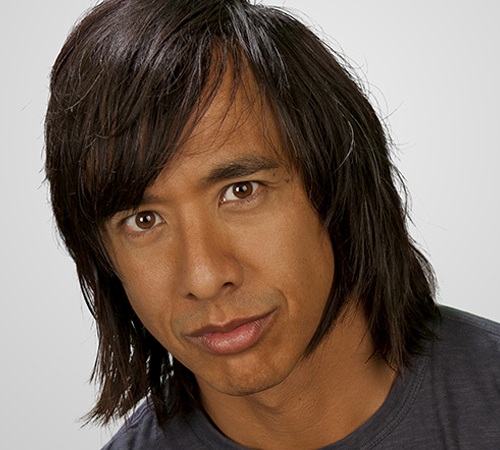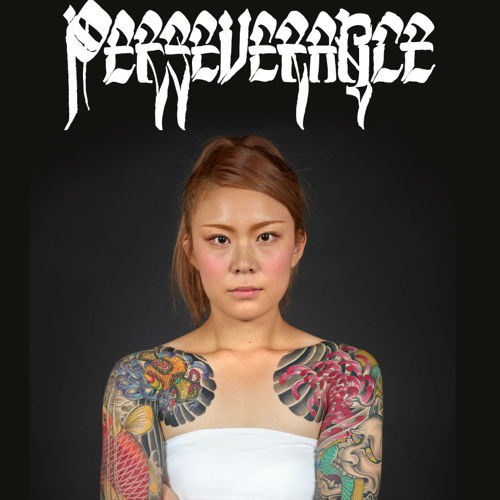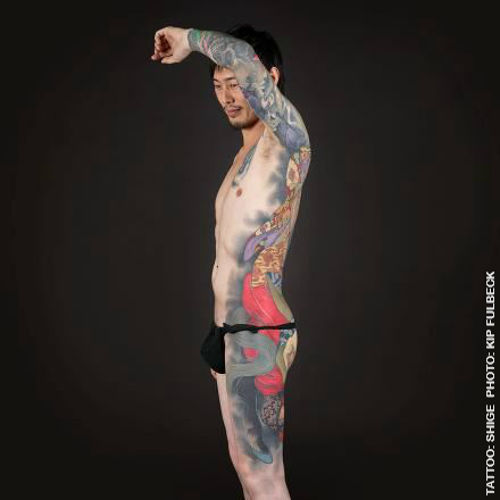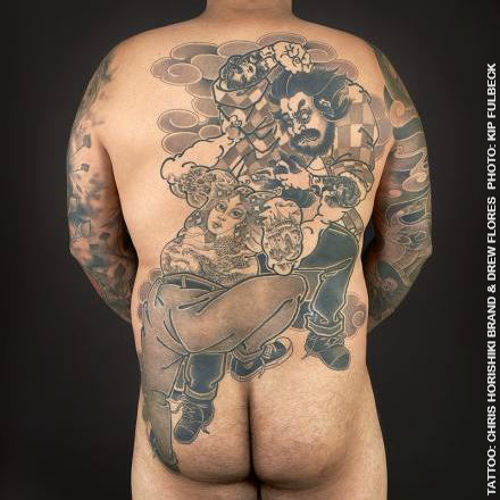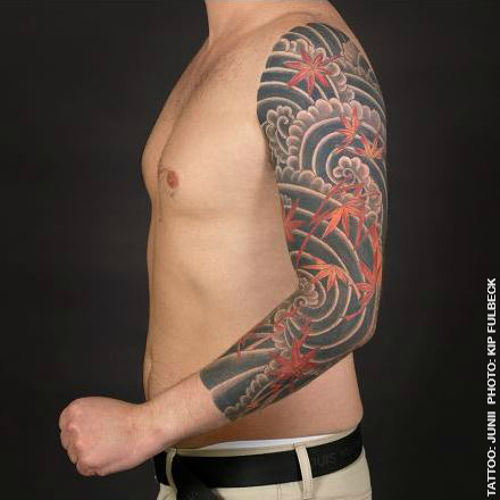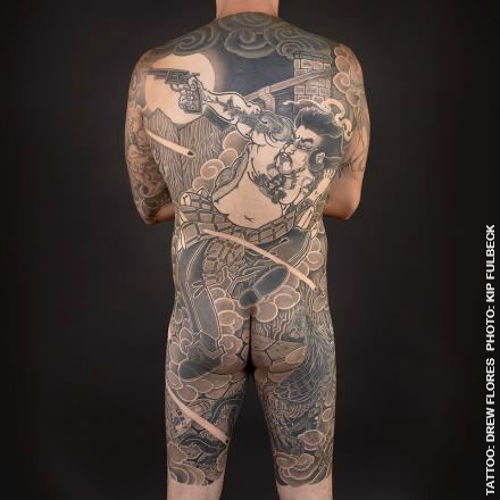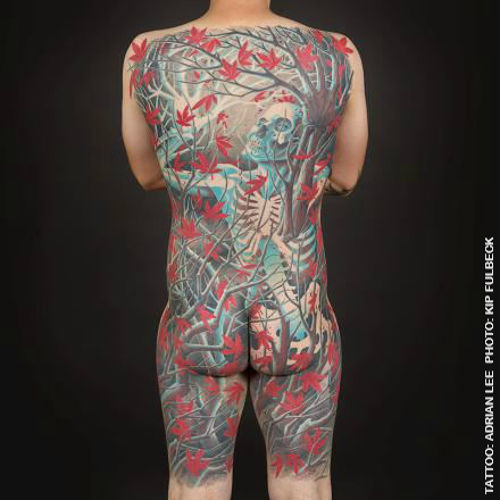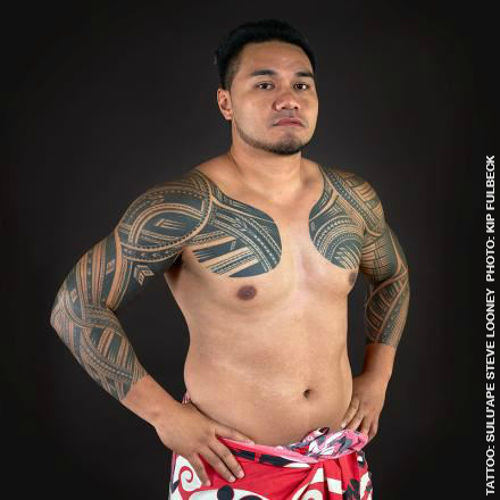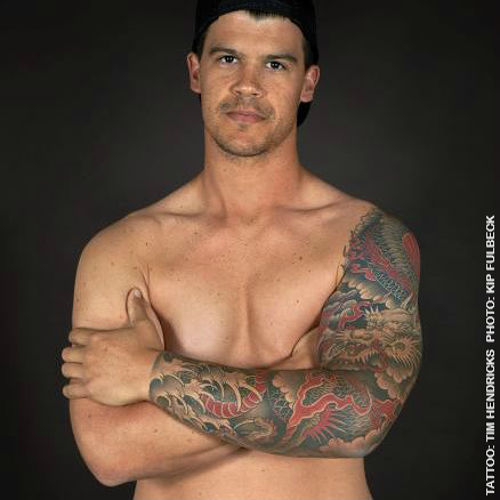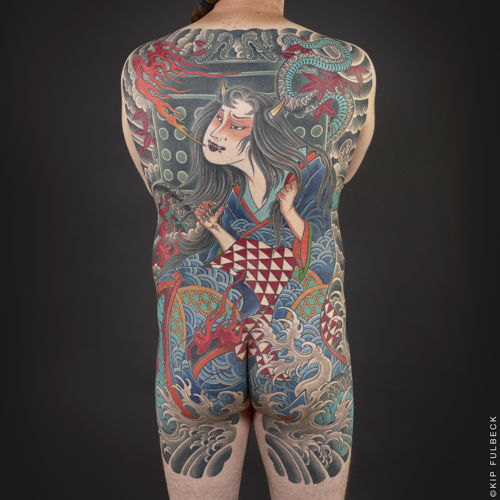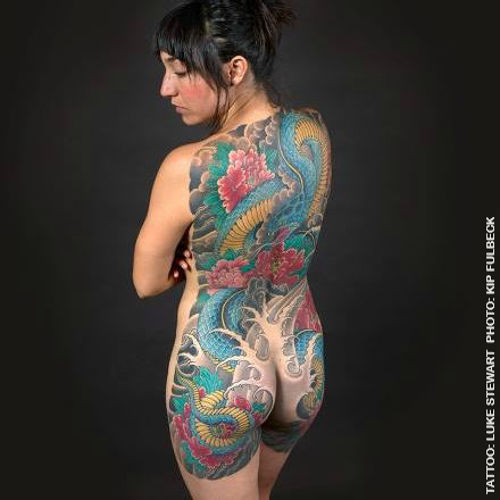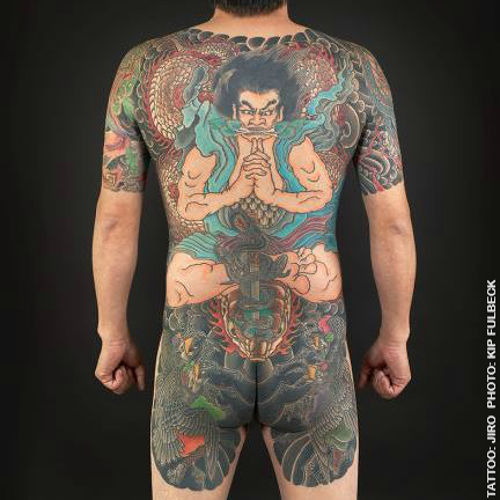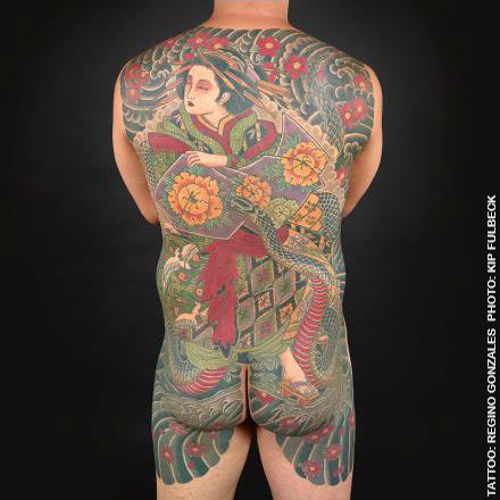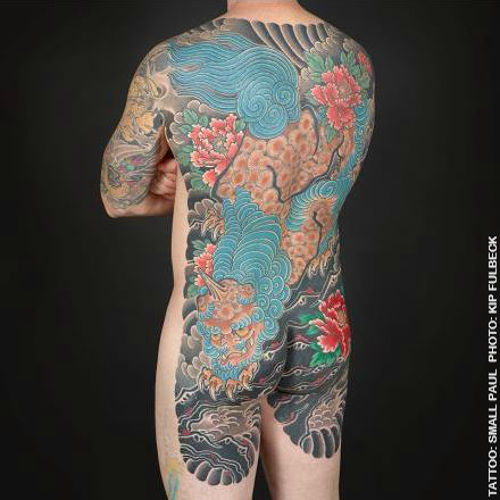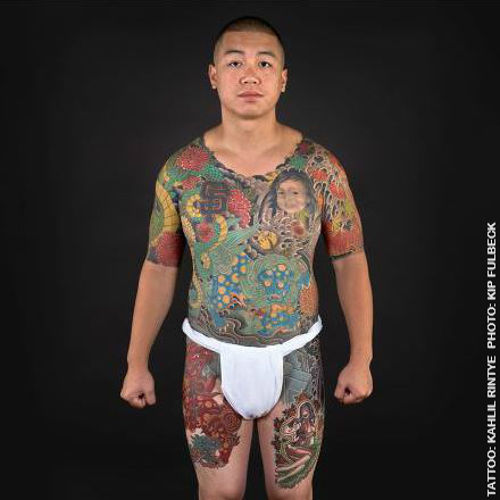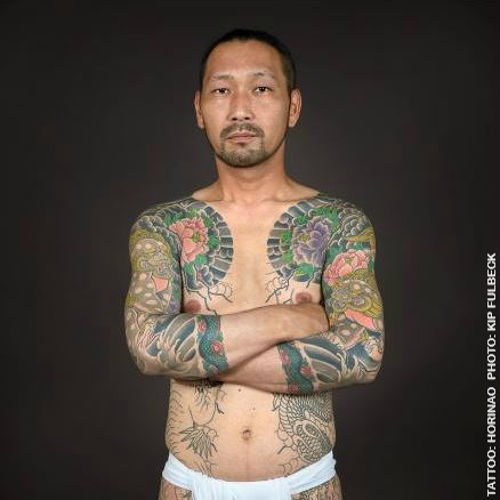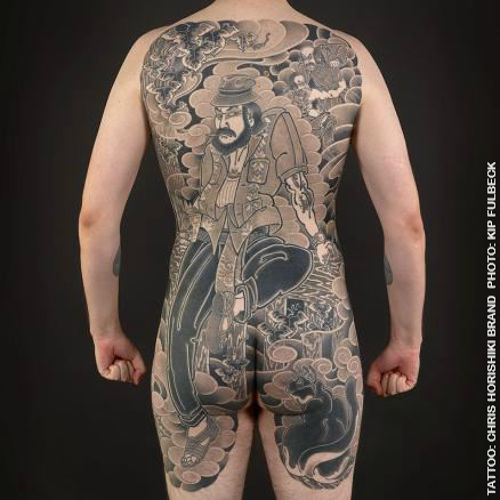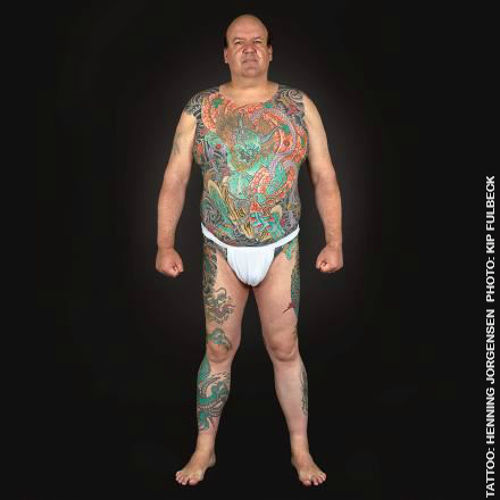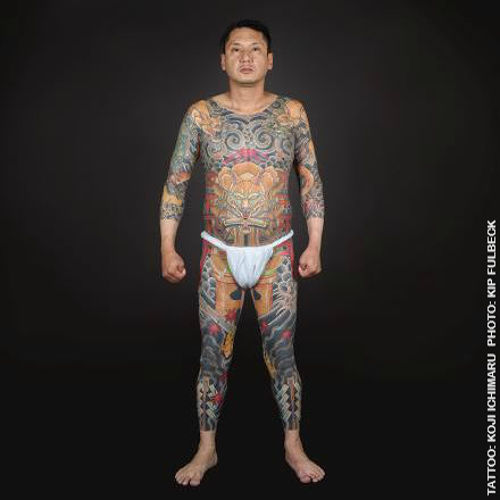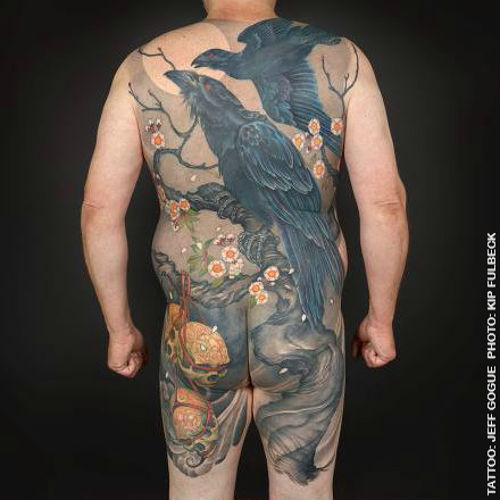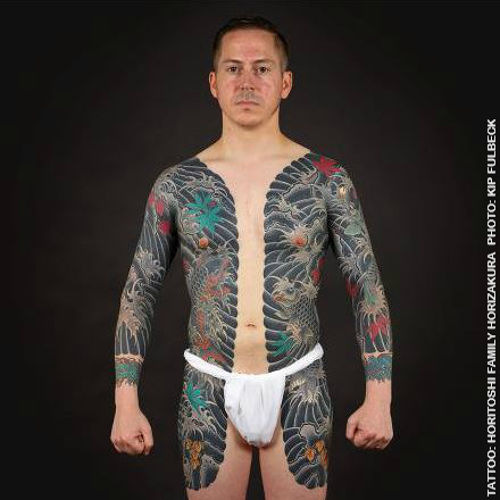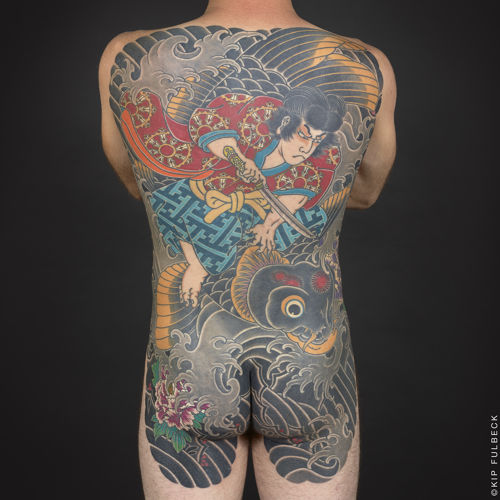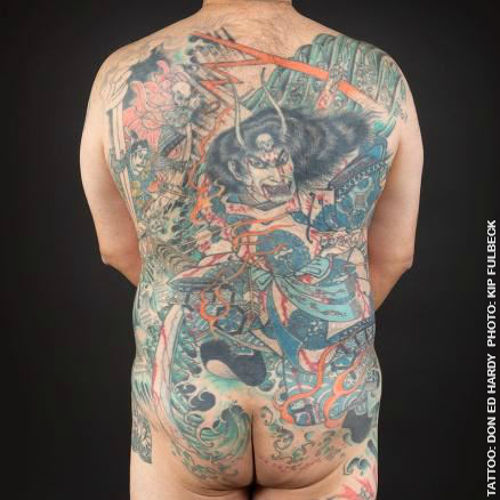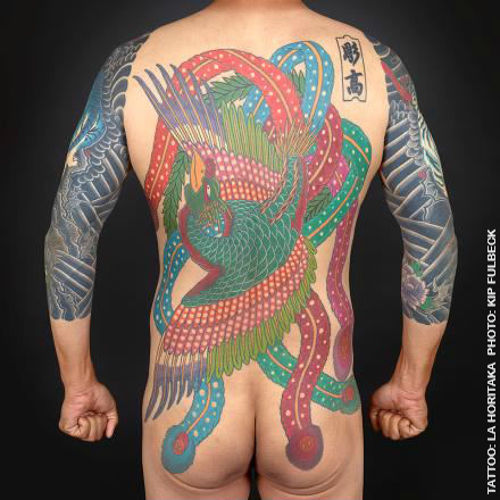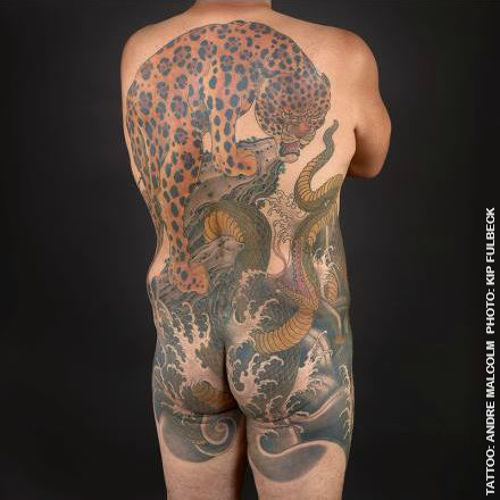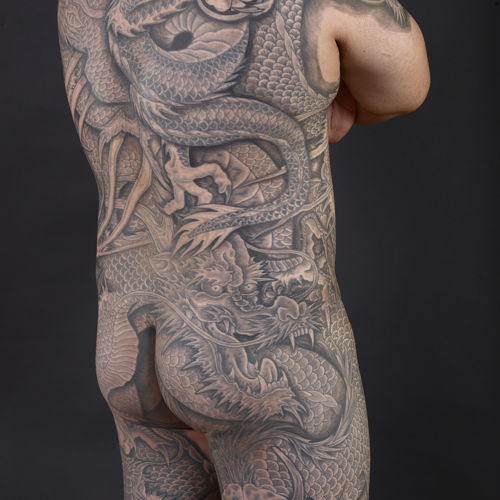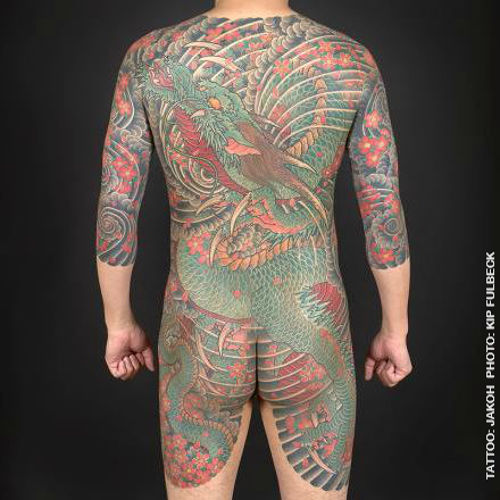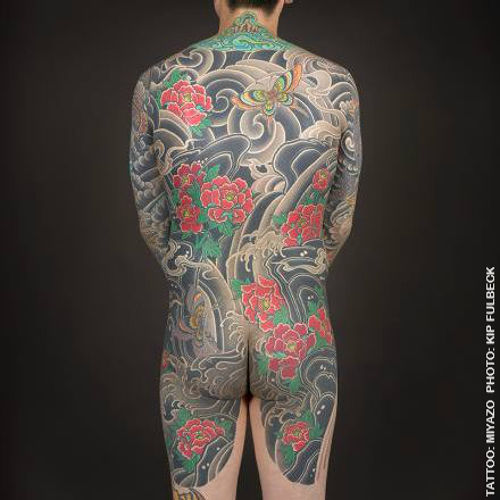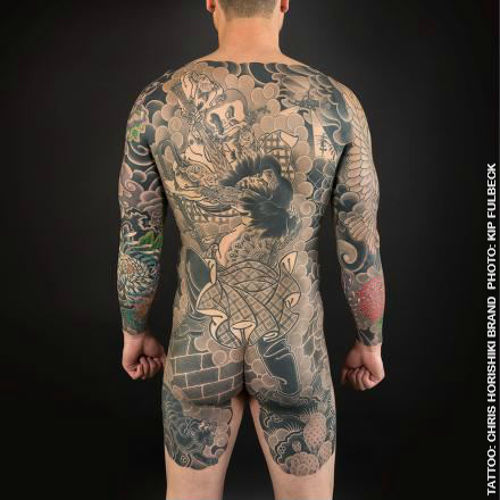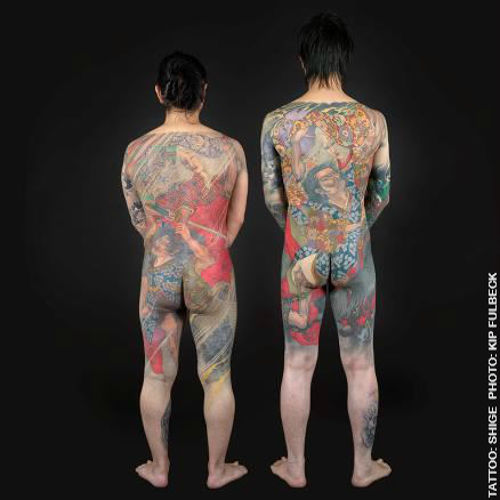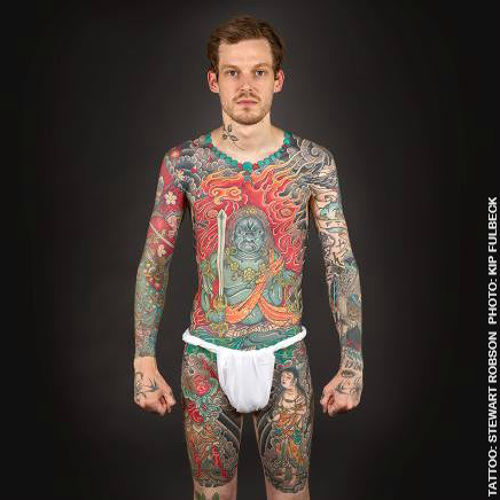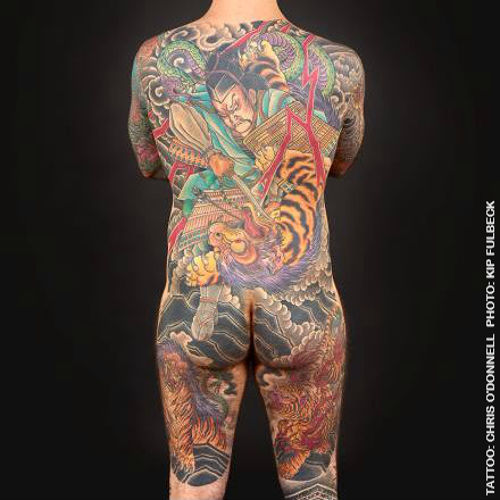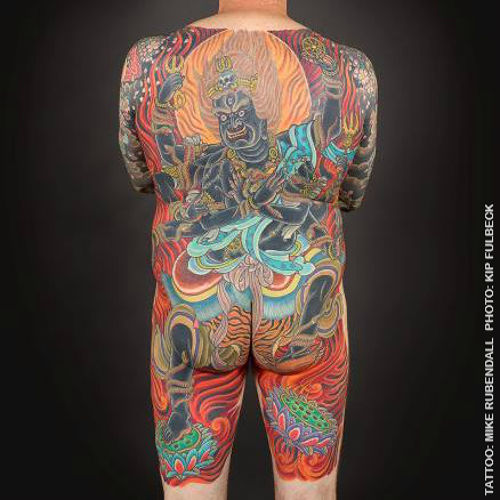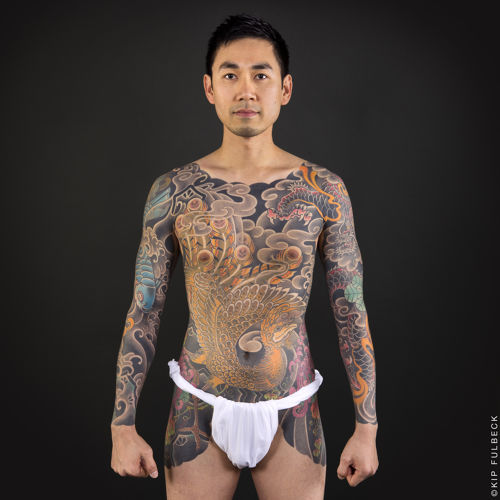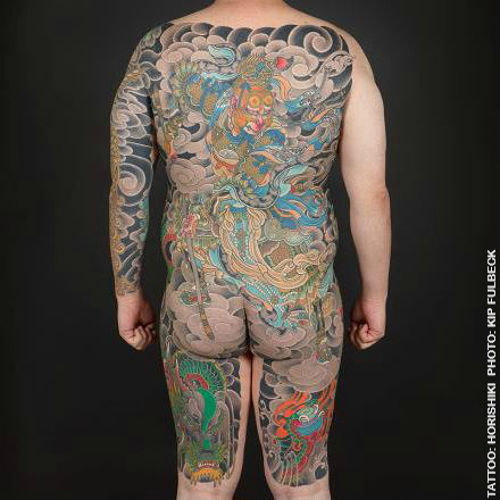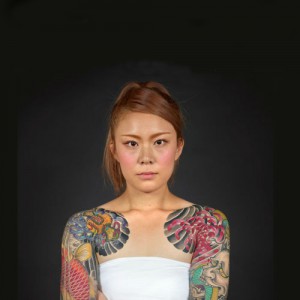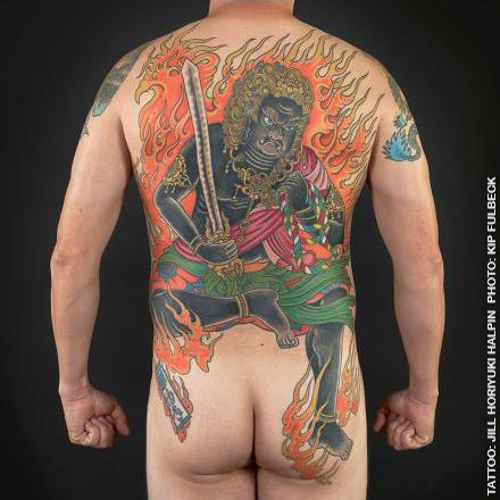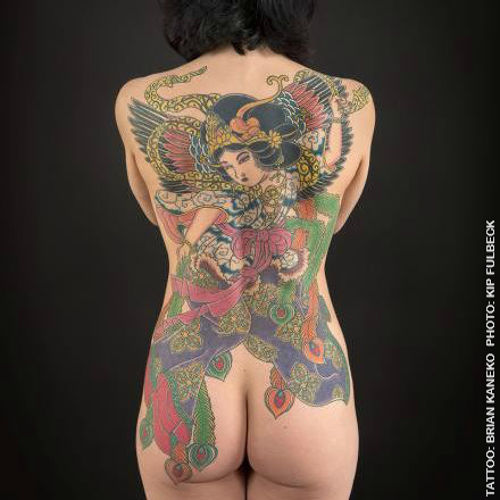Tour Stop: 1
Kip Fulbeck on the exhibition design
The tattoos always feel like they have space to them, they always feel like they have a peacefulness to them, they feel like they exist and they move, and they live and they die, and they never feel like they’re trying too hard. That’s what I wanted to stick with in terms of the design of the show. I think when you say the word “museum” you typically think the word “boring”. I mean, I do. I think “museum” I think “sterile” and I think, stuff on walls with a bunch of academic jargon text below it, and that just drives me crazy. I’m a faculty, I know what academic jargon is, and that’s exactly what I wanted to avoid with this show. I wanted it to be visually dynamic and use all the space – to use the walls, and the floor, and the air, and the sightline, and the light – to use the space as well as these tattooers are using their client’s bodies to make art. That was my challenge. And that was a really hard challenge, because these tattooers in the show are really, really good.
Close
Tour Stop: 2
Kip Fulbeck on the exhibition photography
So I thought what I would do in this exhibition is include these other shots, these candids and these close-ups, because I think that for the newcomer, looking at Japanese tattooing can be really intimidating at times. It is so visually dynamic, and so layered, and so rich when you think about mythology, and the thousands of years of tradition, and the folklore, and the regionalism. And it almost becomes a new visual language that I think is very easy for a newcomer to come in a just gloss over and just not be able to look at it – it just becomes this wash of design. So I thought having these candids and close-ups, along with the documentation of the full pieces, would allow a bit of breathing room, and a bit of humanism to make these clients, you know, show them as people as well as canvases of art. Because that’s essentially what I am – I mean, I wear the work of Horitomo and Horitaka, and I do that proudly. At the same time it’s my body, it’s moving and dying and living with me at the same time. And I wanted to try to capture that as a photographer in this exhibition.
Close
Tour Stop: 3
Takahiro Kitamura on the work of Shige (Sideshot)
My name is Takahiro Kitamura. I’m the curator of this exhibition. And we have been discussing the ever-changing Japanese tattoo tradition, and this is a great example by Shige. Now normally the back piece extends halfway across the ribs, to the point where if you look straight from the back you don’t see any bare skin. And as you see here, Shige’s gone past the middle line in an effort to maximize body space and coverage. He’s essentially creating his own Japanese tattoo form. Close
Tour Stop: 4
Chris Horishiki Brand on collaboration with Drew Flores
This piece shows the seventh and the eighth heroes to be completed in the story 108 Heroes of Los Angeles. This piece was completed in collaboration with the artist Drew Flores and myself. While in the process of creating the depiction of Tornado on Drew’s back, he showed serious interest in the 108 Heroes project and the process I was using in retelling these stories. His potential for learning grew exponentially as we got to know each other.
It was not long before he was ready to join in on the project and collaborate together on a piece of storytelling. We chose this depiction of Malotigre fighting with Decalote, with the intention that each of us could complete a hero on our own, but in the same image. Drew completed Decalote, the gang boss at the top, and I did Malotigre, the traveling dope dealer, at the bottom. Since the completion of this collaboration, Drew has now joined me in the 108 Heroes project, and has gone on to complete four more heroes. Close
Tour Stop: 5
Takahiro Kitamura on the work of Junii
My name is Takahiro Kitamura. I’m curator of this exhibition. I really love this piece by Junii, this three-quarter sleeves – it’s so simple, yet so strong. I think with Japanese tattooing the background is sometimes more important than the actual image it’s encircling, and in this case definitely so. It seems at first like such a simple tattoo, just wind swirls, some lightning, but it’s just so strong. It’s so strong in its simplicity – she really gets it.
Close
Tour Stop: 6
Takahiro Kitamura on the work of Drew Flores
My name is Takahiro Kitamura, I’m the curator of this exhibition, and this is a piece by Drew Flores. Drew has actually picked up where Chris Brand, Chris Horishiki Brand started off, with the 108 Heroes of Los Angeles. Drew has worked closely with Chris, also adding to this collection and this new tradition, if you will. So here what we have is a figure based on an old Japanese woodblock print, but modified to be a new, sort of Chicano LA story, if you will. And it’s a real beautiful piece – I especially like the way he cut the bullets across and the stark contrast he’s used, and the balance of it is really nice. This overall is a great example of a great tattoo.
Close
Tour Stop: 7
Takahiro Kitamura on the work of Adrian Lee
My name is Takahiro Kitamura, and I’m the curator of this exhibit. What we have here is a beautiful tattoo by Adrian Lee. Now Adrian is world famous for sort of a modern take on tattooing. This work is clearly not Japanese, but if you look at it, it uses a Japanese back-piece format. Most Western back pieces tend to stop at the waistline, but just like a Japanese tattoo, he’s brought it down to just above the knees. It’s a great example of how the Japanese tattoo form has influenced other types of tattooing.
Close
Tour Stop: 8
Takahiro Kitamura on the work of Sulu’ape Steve Looney
I’m Takahiro Kitamura, I’m the curator of this exhibition, and what we have is a work by Samoan tattoo master Sulu’ape Steve Looney. This is an amazing example of the usage of Japanese form with other types of tattooing. What we see here is the traditional format of a three-quarter sleeve chest panel – a three-quarter sleeve is called chichibu, and the chest panel is called hikaie. And what Sulu’ape Steve Looney has done here is basically used the framework of the Japanese sleeve and chest panel and filled it with traditional Samoan patterns. This is a departure from the actual traditional Samoan paia, which is an abdomen down to past the knee tattoo. So it’s a very different style, and it just shows the fusion across the world, and how Japanese tattoo forms are being used in other styles of tattooing.
Close
Tour Stop: 9
Takahiro Kitamura on the work of Tim Hendricks
My name is Takahiro Kitamura, and I’m the curator of the exhibition, and you’re looking at a dragon sleeve by Tim Hendricks. Tim Hendricks is such a great tattooer. He’s most known for his black and grey work, portraiture, his sort of chola-style girls – he builds tattoo machines – he’s just an all-around great guy. But I wanted to include this and really show that Tim’s really versatile, he can kind of work in any style he wants. So while Japanese tattooing is not his main emphasis, as you can see here, he’s obviously very good at that as well.
Close
Tour Stop: 10
Tim Hendricks – Dragon Sleeve
This dragon sleeve was actually this guy’s second tattoo. The first one was on his wrist, right down where the lotus flower is. And you can still kind of see a little bit of it left – but this entire sleeve was a cover-up of that small tattoo, which I thought was really cool. This gentleman right here, he is actually an incredible web programmer, and he used to work for a clothing company, and then quit, and now he does a non-profit breast cancer foundation. Which, I think is really noble of him. He’s a really interesting person, and we still talk all of the time and go out to lunch together and, yeah – that’s about it.Close
Tour Stop: 11
Takahiro Kitamura on the work of Horitomo – Dojoji
My name is Takahiro Kitamura, curator of Perseverance, and here’s a beautiful tattoo by Horitomo. It depicts the story of a young girl at Dōjō-ji temple who falls in love with a monk. The monk rejects her advances and in a jealous rage she turns into a snake, and as he hides from her in a bell, she wraps around the bell and burns him to death. Later on, in the Noh theater and Kabuki theater world, this story was told and retold, and she was given the name Kiyohime. So, this is a very beautiful back piece, very striking, and it’s indicative of all of Horitomo’s work. It’s elegant, but strong. He’s a true master of the Japanese tattoo.
Close
Tour Stop: 12
Takahiro Kitamura on the work of Luke Stewart
My name is Takahiro Kitamura. I’m the curator of this exhibition, Perseverance, and here we have a tattoo by Luke Stewart. Luke owns Seventh Son Tattoo in San Francisco, and he was also gracious enough to allow us to photograph there. Luke’s an American tattooer who specializes in Japanese tradition and, as you can see from this snake piece here, does a lot of really amazing work, and is really spearheading Japanese tattooing up there in San Francisco.
Close
Tour Stop: 13
Takahiro Kitamura on the work of Jiro
My name is Takahiro Kitamura, curator of Perseverance. This is a tattoo by Jiro Yaraguchi, also known as Little Tokyo Jiro. And, you know, he certainly lives up to the name because he owns this town. This is a great rendition of Kidomaru, based off of a Kuniyoshi print, and really shows the rich tradition, the lineage from woodblock print to tattoo – this is great. This is a modern masterpiece. Close
Tour Stop: 14
Takahiro Kitamura on the work of Regino Gonzales
My name is Takahiro Kitamura, I’m the curator of this exhibition, Perseverance, and here we have a beautiful piece by Regino Gonzales, a tattooer in New York City. And, I just love the muted tones, and this really brings me back to – I feel like – an older era of Japanese tattooing. It’s a great look, and it’s executed perfectly.
Close
Tour Stop: 15
Takahiro Kitamura on the work of Small Paul
My name is Takahiro Kitamura, the curator of this exhibition. This is a piece by Small Paul, it’s a Karajishi Botan. A karajishi is a Chinese lion, botan is a peony flower. And this combination is really, really significant, it’s very important in Japanese tattooing. The karajishi is considered the king of the beasts, and the peony is the king of the flowers, so the pairing of these two kings is a very special tattoo. And Small Paul has done a very good job on this, it looks wonderful.
Close
Tour Stop: 16
Takahiro Kitamura on the works of Kahlil Rintye
This is Takahiro Kitamura, I’m curator of this exhibition, Perseverance. This is a piece by Kahlil Rintye, and it’s a short-sleeve body suit with the Donburi, chest-filled fashion. And Kahlil is an amazing tattooer, he works up in Tattoo City in San Francisco. I chose this piece because it illustrates something that happens a lot here in the United States, where a client may have some American-style tattoos, some one-point tattoos as we call them, and you can just see what an amazing job Kahlil has done of tying this all together. And I think that’s something that, you know, Sailor Jerry figured out a long time ago, that the Japanese background and the Japanese form, can work and complement other styles of tattooing. And in this case, even when a client has things of a different nature, it can still tie together and make the suit look complete. It’s a wonderful job by Kahlil.
Close
Tour Stop: 17
Takahiro Kitamura on the work of Horinao
My name is Takahiro Kitamura, I’m the curator of the exhibition, and here we have a client of Horinao’s. He has the classic Shichibu and Hikae, seven-tenth sleeve and chest panel. And you can also see – even though his arms are crossed – you can see where they’ve already started outlining his ribs, so he’ll eventually come down to a Munewari chest split. Horinao’s work just blew us away. When we were shooting in Yokohama, he showed up and he had these four clients, and Horinao’s work is just so bold, and strong, and classic. It’s everything I love about the Japanese tattoo.
Close
Tour Stop: 18
Chris Horishiki Brand – Clever
This is the sixth hero to be completed in the story of 108 Heroes of Los Angeles. This is the depiction of the strategist of the gang of 108 Heroes, known as “Clever.” He’s a college professor and a community rights activist secretly working against political corruption and known for helping those in need. He is shown here at his introduction to the story, sitting quietly on his porch with a book and his cat, his moment of peace and quiet being rudely interrupted by a fistfight on the street in front of his house. He soon takes pause to watch the two fight. Police Inspector Wing and a cholo named Diablo duke it out, blow for blow, kick for kick, neither winning or losing. After some time he intervenes, with his great ability for diplomacy, and convinces the two that their skills are so evenly matched that there is no point continuing. One by one, as the story progresses, the three of these men eventually end up working together as high-ranking members of the 108 Heroes.
Close
Tour Stop: 19
Takahiro Kitamura on the work of Henning Jorgensen
My name is Takahiro Kitamura, I’m the curator of Perseverance. When I first invited Henning Jorgensen into this exhibition, I really hoped he’d be able to participate; however I wasn’t sure that he’d be able to get one of his clients to come out. Having body suits and back pieces was no problem—Henning has been doing Japanese tattoos for decades—but he lives in Denmark, and all our shoots were in the United States and Japan. Well, here is Henrik, who is I think definitely the client of the year. He showed up at the Los Angeles shoot—not the New York shoot like we thought. But I guess due to work he couldn’t meet that date, so he flew to L.A., took the photo, and then immediately had his little suitcase and went right back to the airport to fly back. That shows a level of dedication that I think is hard to see in other fields. I think there’s definitely a loyalty and a support for his artist and a sense of gratitude and teamwork. I think that’s a beautiful thing, and we’re very glad to have him in here. Close
Tour Stop: 20
Takahiro Kitamura on the work of Koji Ichimaru
My name is Takahiro Kitamura, I’m the curator of this exhibition, and this is a bodysuit by Koji Ichimaru, a piece he did early in his career. Koji has since relocated to Italy and has been tattooing out there. And his client took a pretty long train ride just to come out for the photo shoot, and I think it speaks volumes about the loyalty that clients have to their tattoo artists. You know, after spending so many hours, and this client was very appreciative of Koji’s work and spoke very fondly of him. And I think that’s a lot of the Japanese tattoo, these relationships that develop, and I think that’s one of the big strengths of the Japanese tattoo.
Close
Tour Stop: 21
Jeff Gogue
This tattoo, for me and my client, represents family, futility, love, and mortality. My client’s daughter is named Raven, and it was a coincidence that I picked two ravens to represent the bond of this family and this marriage, the cherry blossoms to represent the fleetingness of life and beauty, and the skulls to represent the dark places in life and in our lives. I try to aim at a poetic display and a minimal delivery of information so that the viewer can read into it what they see fit.
Close
Tour Stop: 22
Takahiro Kitamura on the work of Horizakura
My name is Takahiro Kitamura, and I’m the curator of this exhibition. This is a piece by Horitoshi family, Horizakura. Horizakura tattoos in New York City, and he’s also a practitioner of Tebori, the Japanese style of hand tattooing. This suit is beautiful, I mean, what can I say – and it’s such a rich example of the Horitoshi family tradition. A great, perfect example of the Munewari chest split – you can just see that great saturation with the hand-poked black ink. This is a wonderful suit, we’re very happy to have photographed it.
Close
Tour Stop: 23
Takahiro Kitamura on the work of Chuey Quintanar
My name is Takahiro Kitamura, I’m the curator of this exhibition, and this piece here by Chuey Quintanar, not only is this is first back piece, but it’s a real great illustration of how the Japanese back piece format works well with other styles. Chuey’s a modern master of the black and grey, of Chicano styles, Aztec, Mayan-influenced styles, portraiture – and it’s really nice to see him do something of this magnitude. This is actually his first back piece, and you can see the impact that he has and how easily Chuey adapted to using a Japanese back piece formula for his style of art. It’s just pure genius and it shows the skill level, and it’s also very nice to see that a master of a different medium would adapt so readily to the Japanese tattoo.
Close
Tour Stop: 24
Takahiro Kitamura on the work of Brian Kaneko
My name is Takahiro Kitamura, I’m the curator of this exhibition, Perseverance, and what we have here is a piece by Brian Kaneko of True Nature Tattoo, it’s Oniwakamaru killing a koi fish – not to be confused with Kintarō, the red baby, fighting with the koi fish. Oniwakamaru is actually the childhood name of the samurai Musashibo Benkei. And Brian’s done an amazing job here, this is just beautiful, and everything about it – the layout, the coloring, the placement – I mean, this is a flawless tattoo. And it shows very heavily his affiliation with the Horitoshi family, and the instruction he gets from them, and it’s just a wonderfully executed tattoo.
Close
Tour Stop: 25
Brian Kaneko – Oniwakamaru
This is Brian Kaneko. This tattoo is of Oniwakamaru. Like a lot of traditional Japanese tattoos, the composition of this piece was very closely modeled after a couple of old woodblock prints, namely one by an artist, Hokkai. What really struck me in this print was his position on top of the fish. I really thought that it struck a nice balance between motion and stability, his arm thrusting forward with the knife, the leg really firmly planted on the fin. I was really attracted to that body position and wanted to use that as the centerpiece.
The fish being so horizontal obviously wouldn’t have fit on a back, so we swooped it up and tried to give the whole thing kind of a downward momentum, a real diagonal flow to the side. And in the original, the colors and patterns on his robes are a bit muted and soft. I wanted something a bit more striking, so I ended up using an old Kuniyoshi print of the same image as an inspiration for the color palate, a lot more pop and strength, and this is what we came up with.
Close
Tour Stop: 26
Takahiro Kitamura on the work of Don Ed Hardy
My name is Takahiro Kitamura, and I’m the curator of the Perseverance exhibit. This is a piece by the one and only Don Ed Hardy, coined as the godfather of modern tattooing, and I think this is actually a pretty accurate term, especially in terms of what we’re talking about now. Certainly Ed Hardy wasn’t the first person to get tattooed in Japan – although he did it in the 70s – but he really is instrumental in educating people in America about Japanese tattooing.
He brought many Japanese masters over to America, his whole…everything about Ed is about education and teaching people about tattoos. This is a beautiful Tomomori that Ed did in the 80s, and we photographed it last year – looks great, of course – and we’re just really proud to have Ed in this exhibit. It seems like Ed is probably the single most important Westerner when it comes to Japanese tattooing, and this show would not have been complete without him.
Close
Tour Stop: 27
Takahiro Kitamura on the work of LA Horitaka
My name is Takahiro Kitamura, I’m the curator of this exhibit, Perseverance, and this is a piece by LA Horitaka that we photographed in Japan. It’s a beautiful phoenix and such a great example of the Tebori hand tattooing style, it’s such a great example of the Horitoshi family style. And it’s also – I love this look—where the back is nokeburi, which means “no background”, and then has these sleeves that kind of frame it – it’s such a great, solid look.
Close
Tour Stop: 28
Takahiro Kitamura on the work of Andre Malcom
My name is Takahiro Kitamura and I’m the curator of the exhibit, Perseverance. This is a piece by Andre Malcolm. I actually invited Andre into the show after seeing this piece in person. It’s just striking, and I think at the end of the day, when we talk about the mythology and the culture of the Japanese tattoo, all of which are important, it still is a visual art. So I think visual appeal is an important thing so I chose this one solely based on aesthetic appeal. It’s a great piece.
Close
Tour Stop: 29
Takahiro Kitamura on the work of Horitaka – Kumonryu
My name is Takahiro Kitamura, curator of Perseverance, and I have a client here who has actually turned himself into Kumonryu, the Suikoden hero. When he first came to me, we did one dragon on him – on his back extending to his arm. And then about a year later he did one from his ribs down his leg. After that one he wanted to discuss where to go from there. We talked about it and I was like, well, why don’t we do nine dragons on you?
So rather than getting the image of Kumonryu, which is very popular – I have two other clients in this exhibit who have Kumonryu tattoos on their back – but rather, this client has actually become Kumonryu. So we tattooed nine dragons on him. I did a bit of conceptual design at first, utilizing no background, rather using the bodies of the dragons to fill up the space. And then later I added a little bit of background just to kind of tie up the loose ends. I’m really happy with this piece, I’ve known this guy for many years, he’s a great friend of mine, and I think this is one of my favorite tattoos I’ve ever done.
Close
Tour Stop: 30
Takahiro Kitamura on the work of Jakoh
My name is Takahiro Kitamura, I’m the curator of Perseverance, and this tattoo by Jakoh is just beautiful. It is everything a Japanese tattoo should be. I remember when the client came in for his photo session, and there were about ten of us there, ten tattooers, and all of us, our jaws just dropped – we were floored. Jakoh is certainly a rising star and his work is sublime. And this is definitely one of my favorite pieces in the whole show.
Close
Tour Stop: 31
Takahiro Kitamura on the work of Miyazo
My name is Takahiro Kitamura, I’m curator of this exhibition, and this tattoo by Miyazo of just rocks, flowers, water, butterflies—it seems so simple but this is really one of my favorite back pieces in the whole show. It’s just such a simple, elegant tattoo, it’s everything right about the Japanese tattoo, and it really also speaks volumes about artistic lineage, between Miyazo and Horitsune and Horitsune II. And Miyazo is the heir to the Horitsune lineage, and he’s certainly carrying on their traditions, and it also shows how important background is. Background…the term itself kind of gives it a secondary nature, but I think in Japanese tattooing it’s actually sometimes even more important than the main image. This is just a beautiful back piece, I love this one.Close
Tour Stop: 32
Chris Horishiki Brand – Dogfight
This piece shows the third and the fourth heroes to be completed in the story 108 Heroes of Los Angeles. Shown here are the two heroes – Padre and the Peacock – sparring together in the street. Padre, like many heroes in the story, is a fugitive on the run from the law. He’s a powerful and honorable man, although his rough personality and fondness for drinking often make him unaware of his strength. It is because of this, that he accidentally killed a butcher that had been abusing a woman. It only took three punches to kill the man.
Shortly after this incident, he skipped town, shaved his head and beard, and disguised himself as a priest. The Peacock is a wealthy young man who is a champion boxer. He is known throughout the city for help in the community, and for flaunting his peacock tattoos, and cruising in his beautiful low-rider. Eventually he is implicated in a crime he had nothing to do with, and is forced to join with the 108 Heroes. Both go on to become high-ranking leaders.
Close
Tour Stop: 33
Takahiro Kitamura on the work of Shige (Modoribashi)
My name is Takahiro Kitamura. I’m curator of the exhibition. Now storytelling is an important part of cultural arts, and here we have a wonderful example by Shige of storytelling through the Japanese tattoo. Both clients tell the Modoribashi story of the samurai Watanabe no Tsuna and his epic fight with the demon Ibaraki-doji at Rashomon gate in Kyoto. Now if you look at the client on the right, you see the initial contact scene where the demon, disguised as a beautiful woman, attacks the warrior on horseback.
The client on the left shows the next scene, where the demon has lifted the samurai into the air. Shige even shows the rooftop of the temple. Watanabe no Tsuna is faster and is about to sever the arm of the demon. Now in the story eventually the demon sneaks back and retrieves its arm, but these two scenes that Shige has shown are the two epic action scenes of the story. Having two clients telling two different parts of the same story is a rare thing, and is indicative of the way Shige thinks and the camaraderie amongst his clients. We had a lot of fun shooting with them in Yokohama. They’re a great bunch.
Close
Tour Stop: 34
Takahiro Kitamura on the work of Stewart Robson
My name is Takahiro Kitamura. I’m the curator of this exhibition. This tattoo is by Stewart Robson, from London, England. His client Andy actually flew to New York just for the photo shoot. He’s got a Fudo Myo-o on his front with two of his attendants, Seitaka and Kongara. This is a great example of how Japanese tattooing is done on a global scale, and done well.
Close
Tour Stop: 35
Takahiro Kitamura on the work of Chris O’Donnell
My name is Takahiro Kitamura, and I’m the curator of this exhibition, Perseverance. And what we have here is a samurai killing a nue, by Chris O’Donnell. A nue is a mythological composite animal – a monster, if you will – in Japanese mythology, and as the story goes, the samurai Minamoto no Yorimasa actually shoots the nue down with an arrow. And then Ino Hayata, as shown here in the tattoo, jumps in and actually kills the nue. This is just a great tattoo by Chris O’Donnell, you can see why he’s one of my favorite tattooers. Everything he does is just gorgeous, and this is a great example of an American doing very, very nice Japanese work.
Close
Tour Stop: 36
Takahiro Kitamura on the work of Mike Rubendall
My name is Takahiro Kitamura, I’m the curator of this exhibition – and this is a Gundari Myo-o back piece by Mike Rubendall. Mike’s one of my favorite tattoo artists, and it’s easy to see why. He has such a rich, colorful saturation here, and if you really study up on it, he’s done a lot of research so you know the piece is correct – everything is as it should be. One thing that I think is very interesting, is, because of the dark colored nature of the figure, Mike chose to go with more of a flame background, which I think works beautifully. And it’s just an example of a great piece, great balance, and that’s why I chose it for the show.
Close
Tour Stop: 37
Mike Rubendall – Gundari Myoo
Hey, my name is Mike Rubendall. I’m a tattoo artist from New York, and this is a back piece I did in 2011. It took approximately 90 hours from start to finish, and this specific character that you’re looking at is a deity named Gundari Myo-o. And Gundari Myo-o is one of the five great wisdom kings – one of the five Myo-o, being associated with Fudo Myo-o, the most famous. And Myo-o is a group of war-like deities. They’re known as mantra kings, or wisdom kings, or knowledge kings. And typically you’ll see a Myo-o statue appear ferocious and menacing. You’ll see it with threatening postures and threatening and ferocious faces, and that’s basically designed to subdue evil and frighten unbelievers into accepting Buddhist law. They represent the luminescent wisdom of Buddhism, they protect the Buddhist teachings, remove all obstacles to enlightenment, and force evil to surrender.
Gundari Myo-o represents the South, and is called the enemy of devils, which is part of the reason for his fierce looks. You will often see Gundari Myo-o standing with his feet on lotuses. His left foot is sometimes raised and his body in the act of leaping. You can see here he has three eyes, fangs, he has a human skull within his headdress. He has eight arms, and you’ll often find serpents or snakes coiled around his ankles and wrists. If you look, he has two hands crossed upon his breast. The lower-right hand is open and pointing to the earth, the second is in a mudra position, and the third holds a vajra. One left hand near the knee holds a kind of an axe, if you’ll see, and the other holds a long stick and it has a trident on the end. The third one is holding a wheel right about the height of the head. Now these are all very important components that make up Gundari Myo-o. In my opinion, it’s also very important to study and research these subjects very thoroughly before tattooing them.
Close
Tour Stop: 38
Chris Horishiki Brand – Golden Phoenix
This piece is a prime example of a very dedicated individual. It was because of this dedication that we were able to complete such a large amount of work in a relatively short time. He had set goals for himself and had budgeted himself appropriately for these goals. I always try to encourage people to take this kind of approach to getting large-scale work. We would sit for two-hour sessions every week until a portion was complete.
First we did the koi sleeve, then a small break for a week or two, then we moved over to the dragon and did the same two-hour sessions once a week until it was complete. After another short break, we started the phoenix on his front. This time we took a slightly different approach and split our time, also working on his back. We would do the same two-hour sessions every week, but switching front to back every few weeks or so. This approach, combined with keeping our sessions to only two-hours each, helped him deal with the considerable pain involved in varying areas of the torso, and still complete so much work in a very short amount of time.
Close
Tour Stop: 39
Chris Horishiki Brand – Monkey King
This is a depiction of the monkey king. He’s known in Japanese mythology as Son Gokū. He originally comes from the classic 16th-century Chinese novel Journey to the West, where he is known as Sun Wukong. Along with his legendary fighting skills and immense strength, his Daoist supernatural powers give him the ability to change shape. In stage plays, woodblock prints, television shows and tattoos, the telling and retelling of his story has been done for generations. It was this collector’s fondness for the very loosely-based retelling in the popular contemporary Japanese cartoon Dragon Ball that led to this piece being completed. Close
Tour Stop: 40
Takahiro Kitamura on the work of Horikiku
My name is Takahiro Kitamura, I’m curator of this exhibition, Perseverance, and what we’re looking at is a client of Horikiku’s. Horikiku tattoos in Yokohama. He’s traditionally apprenticed and also does tebori as well. This is a great example of Shichibu, seven-tenth sleeves and chest panel. And we’re all just struck by the look of this woman. Like, you know, she has such an intensity in her eyes, such an amazing, unwavering gaze. And it was funny, because her son was with her and he was joking, “that’s the look my mom gives me when she’s mad,” [laughs]. But anyhow, that intensity is what led to us featuring her not only in the show, but on the cover of the catalogue as well as the outside sign.
Close
Tour Stop: 41
Jill Horiyuki Halpin – Fudo myo-o
My name is Horiyuki. I have been tattooing for eighteen years and work at State of Grace. The image you are looking at is a back-piece tattoo of the god Fudo Myo-o. In Horitomo’s book, Immoveable, he describes Fudo Myo-o as an angry manifestation of the principal icon of esoteric Buddhism, Dainichi Nyorai. Dainichi Nyorai assumes this frightful form to teach and lead the most obstinate nonbelievers to salvation. In this depiction of Fudo Myo-o, he holds the sword Eto in his right hand. In his left, Kensegu, the rope of five colors representing the five wisdoms and five elements of the universe.
His facial expression is wrathful, and he wears the garb fitting of a Buddhist deity: robes adorned with gold jewelry. His hairstyle is typical. The long lock gathered to the left side of his face is known as benpatsu. He sits on a natural rock pedestal, called a niwasa. Finally, his body is engulfed in a flame, and embodies the silhouette of a magical bird called karura. The client’s profession is that of a firefighter. Perhaps that is what attracted him to this image.
Close
Tour Stop: 42
Brian Kaneko – Tennyo
This is Brian Kaneko. This piece is a tennin, or tennyo – its sort-of a Japanese Buddhist angel, or celestial spirit. In this depiction she’s wearing a hagoromo – which is a feathered robe. It’s a very famous Noh play, as well. This situation was unique when the client approached me, in that she knew she wanted her whole back tattooed, she had a cover-up between her shoulders that she wanted to accomplish, but beyond that, she wasn’t exactly sure what type of image she was interested in. So I asked her to write me a list of thoughts, just abstract shapes, colors, feelings, things that she associated with herself.
She brought me back a list of – I believe it said stars, clouds, dance, female energy, flight, wings, spirals, vajras – and this was the first thing that popped into my head. And we were very lucky in that we were really able to capture so many of the different abstract thoughts that she had into a very cohesive image that has a lot of historical provenance in Japanese culture and tattooing. And I feel that we were both very, very happy with the result, and it worked out in a really unique and good way.
Close
